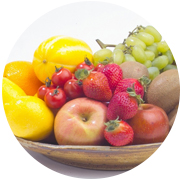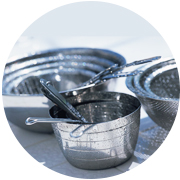

|
 What is food additives?
What is food additives?

 Food additives(sterilizer) - For food
Food additives(sterilizer) - For food |
Food Sterilizing process |
 |

 Disinfectants for furniture and others - For apparatus
Disinfectants for furniture and others - For apparatus |
Sanitizing Cooking Utensils |
 |
 The standard of sterilizing power
The standard of sterilizing power| Standard for foods | ||
| The name of food additive | Sodium Hypochlorite | |
| Synonym | Hypochlorite | |
| Chemical formula | NaClO | |
| Molecular weight | 74.45 | |
| Definition | It is a device which generates sodium hypochlorite as an effective component, Including saline solution by electrolyzation. |
|
| Content | It contains over 4.0% of available chlorine. Gaining sterilizing water by saline solution contains over 100ppm of available chlorine. |
|
| Description | It has a chlorine odor as a light greenish yellow liquid | |
| verification test |
(1) It appears yellow color when staining test. (2) It generates gas when adding the dilute hydrochloric acid. (3) If you put red litmus paper into this item, it will turn to blue and then fade away. |
|
| Quantitative method |
After weighing 3g of this item with accuracy, add 50ml of water and then 2g of potassium iodide and 10ml of acetic acid and titrate the liberated iodine with 0.1N Sodium thiosulfate standard solution. (Indicator: Starch test solution) perform a blank test separately in the same method. But take exactly 10ml of the sodium hypochlorite produced by apparatus for preparing sodium hypochlorite, add 50ml of water and then 1g of potassium iodide and 10ml of acetic acid and titrate the liberated iodine with 0.01N sodium thiosulfate standard solution. Na2S2O3 solution |
|
| Use standard of sodium hypochlorite |
Do not use sodium hypochlorite for purpose other than disinfection of food such as fruits, vegetables, etc. and it should be removed before the final products is completed. But, it shall not be used for sesame. |
|
| Standard for devices | ||
| The name of food additive | Sodium Hypochlorite Preparations | |
| Chemical formula | NaClO | |
| Molecular weight | 74.44 | |
| Definition |
It is a device which generates sodium hypochlorite as an effective component, Including saline solution by electrolyzation. |
|
| Description | It has a chlorine odor as a light greenish yellow liquid | |
| Verification test |
(1) Use diluted solution added with water to contain 50~100㎍ active chlorine in each 1ml of This
item as a test solution. Separately, use sodium standard solution produced after taking 0.5mL of
undiluted sodium standard solution and adding water to make it total 100mL. When tested
according to the Atomic Absorption Spectroscopy by using sodium standard solution and test
solution, the peak of the sodium should be checked.
(2) When 1ml of sodium hydroxide solution (1→2,500) and 0.2mL of potassium iodide solution added into 5mL of test solution in (1), the liquid turns to yellow and then to dark blue when 0.5mL of starch test solution is further added. (3) When 0.1ml of potassium permanganate (1→300) added into 5mL of test solution in (1) and again 1mL of sulfuric acid (1→20) added into the liquid, the red purple color of the liquid does not fade away. (4) The liquid produced by adding 100mL of sodium hydroxide solution (1→5) into 90mL of test solution in (1) has a maximum absorption area in the wavelength ranging 290~294㎚. |
|
| Test of sterilizing power | This item should be suitable for Assessment of Quantitative Suspension Tests of Sanitizers and Disinfectants. | |
| Use standard of sodium hypochlorite |
Less than 200ppm [The device for restaurant business, food service facilities] Less than 200ppm [The device for brassware] Less than 200ppm [Manufacture of a food, Mechanism for food] |
|
 Safety of sodium hypochlorite
Safety of sodium hypochlorite| The designated state in other countries | ||
| USA(FCC 5) |
EPA 40 CFR chapter I part 180.940 Food-contact surface sanitizing solutions; exemptions from the requirement of a tolerance (2004) |
|
| EU |
Active Substances listed in Annex Ⅱ of COMISSION REGULATION (EC) No 2032/2003 as amended by Regulation (EC) No 1048/2005,Product-type 4 (Food and feed area disinfectants) among Main group1: Disinfectants and general biocidal products |
|





